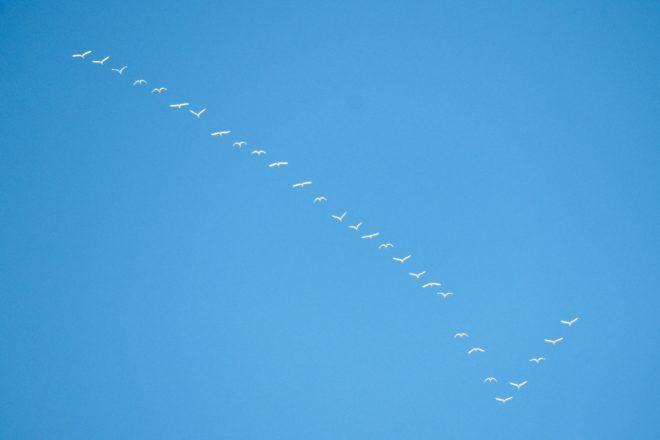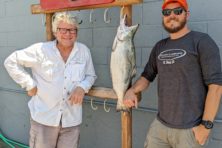Wild Things: Record Haul for Fish, Wildlife
- Share
- Tweet
- Pin
- Share

Wisconsin nets $46.8 million from feds
by KEVIN NAZE, [email protected], Peninsula Pulse contributor
For the second straight year, the Wisconsin Department of Natural Resources (DNR) will receive a record amount of funding from the U.S. Fish and Wildlife Service (USFWS).
The $46.8 million apportionment – about $3.2 million more than last year and $14.4 million more than in 2021 – comes from federal grant programs funded by excise taxes on firearms, bows, ammunition, fishing tackle, import duties on tackle and pleasure boats, and a portion of the gasoline fuel tax attributable to small engines and motorboats.
The USFWS will be distributing a record $1.6 billion. Wisconsin’s share is $33.7 million in wildlife-restoration funds (including $6 million for hunter education) and $13.1 million in fish restoration. Payments are largely based on land and water area and the number of paid hunting and fishing license holders in each state.
The DNR uses the money for programs and projects that support fish and wildlife management and research, habitat improvement, public access, hunter education, and the development and management of public shooting ranges.
Wildlife watchers, hikers, boaters and others who enjoy public lands and waters also benefit through increased outdoor recreational opportunities and aquatic-resources education programs.
The federal programs began in 1937 with the Pittman-Robertson Act for wildlife, in 1950 with the Dingell-Johnson Act for fish, and in 1984 with the Wallop-Breaux Amendment for the boating industry.
To date, the U.S. Fish and Wildlife Service has distributed more than $27 billion in apportionments for state conservation and recreation projects. The federal dollars typically fund up to 75% of project costs, and most states must provide a matching share of up to 25% from hunting and fishing license revenues.
Wisconsin moved up one spot from last year in sportfishing funding, getting the sixth-highest distribution. Only Alaska, Texas, California, Florida and Minnesota received more. Wisconsin dropped one spot, to 10th, in wildlife funding. Texas, Alaska, Pennsylvania, California, Georgia, Minnesota, Michigan, Tennessee and Arizona received more.
In addition, the DNR is slated to receive more than $983,000 from the USFWS for the State Wildlife Grant Program. These funds come via an annual general appropriation to support species of greatest conservation need. You can see Wisconsin’s plan at dnr.wisconsin.gov/topic/WildlifeHabitat/actionPlanSGCN.html.
Meanwhile, the USFWS reports that more than $120 million in sport fish funds were also used nationally, including nearly $29 million for the Boating Infrastructure Improvement Program, and more than $20 million for both the North American Wetlands Conservation Account and the Coastal Wetlands Program.
Additionally, nearly $16 million in previously apportioned funds that weren’t spent within the time frames set forth have been transferred to the Migratory Bird Conservation Fund, and nearly $26 million in accrued interest from investments was transferred to the North American Wetlands Conservation Account.
Conservation Congress Elections April 4-5
Door and Kewaunee county residents can vote for local representation on the Wisconsin Conservation Congress (WCC) during a pair of meetings next week: Tuesday at Sturgeon Bay High School and Wednesday at Kewaunee High School. Doors will open at 6 pm, and voting will begin at 7 pm.
A panel discussion with Department of Natural Resources staff and WCC delegates will follow the elections. DNR representatives will provide a brief update on issues pertinent to the county. WCC delegates will provide an overview of their work on the WCC and what the organization is all about, and there will be an opportunity for questions and answers.
Meanwhile, the annual DNR and WCC fish and wildlife spring hearing questionnaire will be open April 10-13. Put it on your calendar; then find it at dnr.wisconsin.gov/about/wcc/springhearing.
Safety Education
Thinking about taking a boating, hunting or all-terrain vehicle/off-highway motorcycle safety-education course? Now’s a good time to scout for upcoming classes.
If you don’t already have a DNR customer ID number, you’ll need to obtain one in order to register for a class. The easiest way to do that is by calling DNR customer service at 1.888.936.7463 between 7 am and 10 pm. Your Social Security number and driver’s license number are required to create an account.
Learn more at dnr.wisconsin.gov/Education/OutdoorSkills/safetyEducation.
Last Call on Tags
More than 7,300 bonus Zone 2 wild turkey tags for period E – the fifth week of the season – sold out in just two hours last week, but more than 2,000 extras for the sixth period were still available as of March 28.
The first hunt regular hunting period begins April 19, but the youth hunting weekend is April 15-16. Eligible hunters participating in the youth hunt must have a regular season tag. If a youth gets a bird, that tag then becomes invalid. If the youth hunter doesn’t get a bird, the tag is still valid for the period for which it was authorized.
Elk Applications
Hunters can apply for a shot at a once-in-a-lifetime Wisconsin elk tag through May 31. The cost is $10, with a limit of one application per person. You can purchase an unlimited number of $10 raffle tickets for a chance at a single tag to be awarded through a Rocky Mountain Elk Foundation draw.
Learn more at dnr.wisconsin.gov/topic/hunt/elkhunting.html and rmef.org.
Weekly Lake Levels
As of March 24, Lake Michigan was just four inches above its long-term average and down 31 inches since the monthly record was set three years ago. Levels are still 33 inches above the record low, set in 1964, and are expected to rise four inches during the next month.



